
Chipmunks are small, striped rodents of the family Sciuridae. Chipmunks are found in North America, with the exception of the Siberian chipmunk which is found primarily in Asia.

The Annonaceae are a family of flowering plants consisting of trees, shrubs, or rarely lianas commonly known as the custard apple family or soursop family. With 108 accepted genera and about 2400 known species, it is the largest family in the Magnoliales. Several genera produce edible fruit, most notably Annona, Anonidium, Asimina, Rollinia, and Uvaria. Its type genus is Annona. The family is concentrated in the tropics, with few species found in temperate regions. About 900 species are Neotropical, 450 are Afrotropical, and the remaining are Indomalayan.

Vigna is a genus of flowering plants in the legume family, Fabaceae, with a pantropical distribution. It includes some well-known cultivated species, including many types of beans. Some are former members of the genus Phaseolus. According to Hortus Third, Vigna differs from Phaseolus in biochemistry and pollen structure, and in details of the style and stipules.
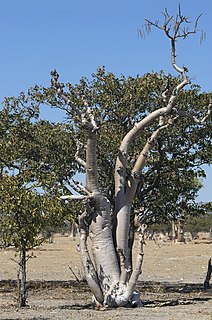
Moringa, native to parts of Africa and Asia, is the sole genus in the flowering plant family Moringaceae. The name is derived from murungai, the Tamil word for drumstick, and the plant is commonly referred to as the drumstick tree. It contains 13 species from tropical and subtropical climates that range in size from tiny herbs to massive trees. Moringa species grow quickly in many types of environments.
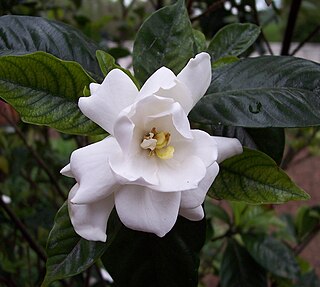
Gardenia is a genus of flowering plants in the coffee family, Rubiaceae, native to the tropical and subtropical regions of Africa, Asia, Madagascar and Pacific Islands, and Australia.

Myrica is a genus of about 35–50 species of small trees and shrubs in the family Myricaceae, order Fagales. The genus has a wide distribution, including Africa, Asia, Europe, North America and South America, and missing only from Australia. Some botanists split the genus into two genera on the basis of the catkin and fruit structure, restricting Myrica to a few species, and treating the others in Morella.
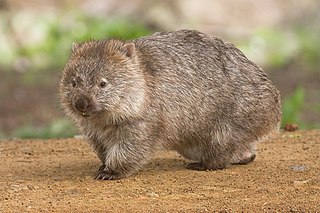
The common wombat, also known as the coarse-haired wombat or bare-nosed wombat, is a marsupial, one of three extant species of wombats and the only one in the genus Vombatus. The common wombat grows to an average of 98 cm (39 in) long and a weight of 26 kg (57 lb).

Gomphia is a genus of plant in the family Ochnaceae. The generic name is from the Greek meaning "thorn or spike", referring to the shape of the flower base when the fruit develops.
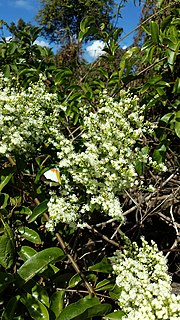
Metaporana is a genus of plants in the bindweed family Convolvulaceae.
Polysphaeria is a genus of plant in the family Rubiaceae, and its native range is Madagascar and Tropical Africa. It contains the following 22 species according to Plants of the World Online:

Seddera is a genus of plants in the bindweed family Convolvulaceae.

Ammannia is a genus of around 100 species of plants often referred to as redstems from wet areas in America, Africa, Asia, Australia and Europe. Several species are grown as decorative plants in aquariums.
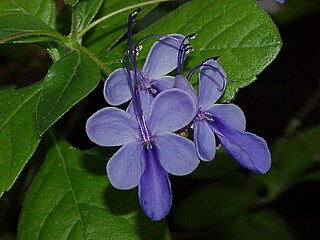
Rotheca is a genus of flowering plants in the family Lamiaceae. Estimates of the number of species in the genus vary from about 35 to as many as 60. Three of the species are native to tropical Asia, with the rest occurring in Sub-Saharan Africa. The type species for the genus is Rotheca serrata. It had originally been named Rotheca ternifolia, but this name is now considered illegitimate.
Adenodolichos is a genus of shrubs in the legume family Fabaceae, native to tropical Africa.
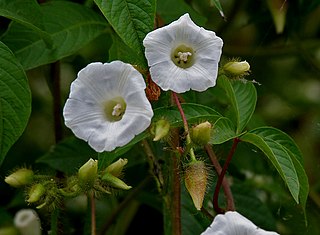
Merremia is a genus of flowering plants in the morning glory family, Convolvulaceae. Members of the genus are commonly known as woodroses.

Pentanisia is a genus of flowering plants in the family Rubiaceae.
Chazaliella is a genus of flowering plants in the family Rubiaceae. It has about 20 species native to tropical Africa from Liberia to Tanzania and south to Zimbabwe.

Ipomoea sagittifolia is a species of morning glory in the genus Ipomoea. It is native in many countries and is used in traditional Indian medicine because its seeds contains the indole alkaloids ipobscurine A, B, and C. The species is sometimes called Ipomoea marginataVerdc..















